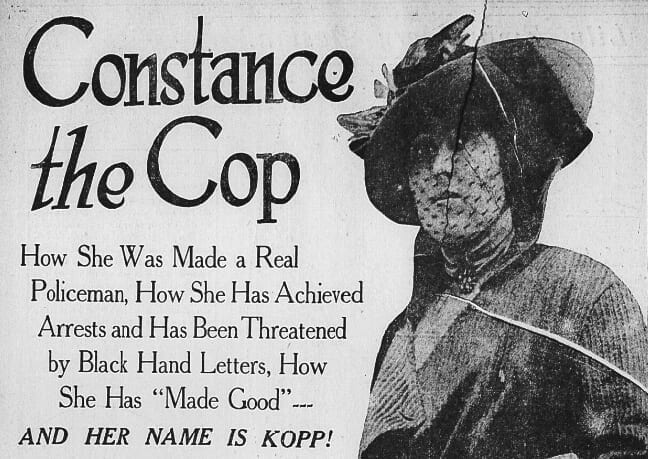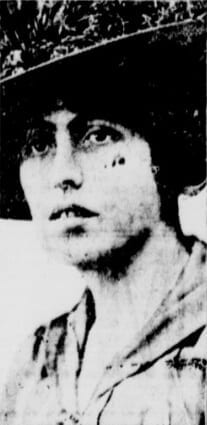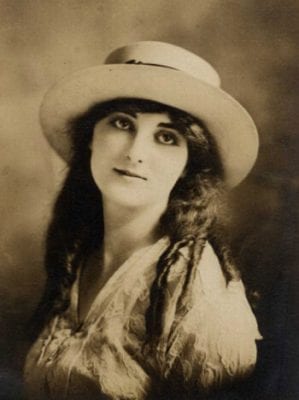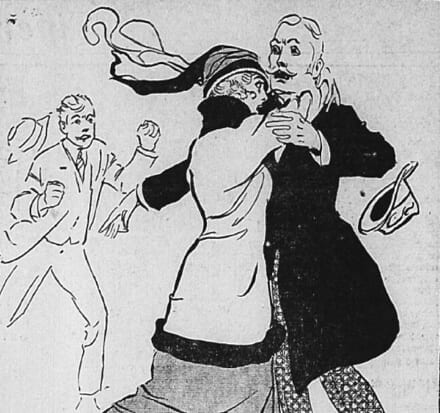How Constance Kopp Became First Female Sheriff’s Deputy

A 1916 newspaper article covering Constance Kopp’s rise to sheriff’s deputy. (Source)
March 14, 2021 ~ By Shari Rose
Henry Kaufman Crashes into Constance Kopp’s Buggy

Constance Kopp in 1915. (Source)
The eldest of three girls, Constance Amelie Kopp, was born in 1877. She and her two other sisters, Norma, and Fleurette, lived with their widowed mother on a farm in Wyckoff, New Jersey.
In June 1914, Constance and Norma were driving in their buggy when a silk factory owner named Henry Kaufman crashed into them with his new automobile. Kaufman was to blame for the accident, and Constance Kopp sought fair compensation from the wealthy silk manufacturer.
Then, the threats came.
Kopp Sisters Receive Anonymous Threats
The Kopp sisters received a threatening letter at their home in June 1914, soon after Kaufman crashed into their horse-drawn buggy. Despite the anonymous threat, Constance Kopp moved forward with a civil suit against Kaufman. She prevailed, and was awarded $50 for damages caused by the crash. However, the factory owner failed to pay her.
So, when Kopp recognized Kaufman’s automobile in the street one day, she ran after it, and shouted for fellow pedestrians to help her stop the car. Eventually, she created enough of a spectacle and Kaufman was forced to stop.
A policeman on the scene spoke to Kaufman for a while before seizing his vehicle and forcing the factory owner to pay his $50 judgement. Kaufman paid Constance Kopp on the spot, undoubtedly in front of a large crowd, and drove away quickly.
Constance Kopp Asks For Sheriff Heath’s Help
After Kopp received her court-ordered payment, the anonymous letters escalated. The Kopp family received letter after letter to their home that threatened violence against the young women. On many nights, strange men walked onto the property and shot beneath the home’s windows.
With the terrifying escalation, Constance Kopp talked to the police. Though some deputies scoffed at her story, Bergen County Sheriff Robert N. Heath took the young woman seriously. He assigned a deputy to guard the Kopp’s home in Wyckoff and visited often. Constance spoke about his efforts to keep them safe:
“We lived in constant terror. But Sheriff Heath came to our assistance and provided us with a guard at our home. He even took the trouble to bring the deputy from Hackensack everyday. I don’t know what we would have done without his assistance…”
Around this time, a drunk Henry Kaufman was driving his car with some friends when he spotted Constance Kopp walking on the street. He verbally berated her until a patrolling officer arrested him. Kaufman was fined $5.00 for the harassment.
Due to these credible threats the Kopp sisters faced, they were given special permission to carry firearms.
“If we ever catch a strange man sneaking around our house after dark, we will use our revolvers,” Constance Kopp said.

Cartoon rendering of the three Kopp Sisters carrying revolvers in a 1916 newspaper article. (Source)
“Girl Dressed In Black” Ransom Letter
In November 1914, five months after the crash, the Kopp sisters received a threatening letter:
“Madam—We demand $1000 or we will kill you. Give Monee (sic) to a girl dressed in black at the corner of Broadway and Carroll street, Paterson, Saturday night. If you don’t pay we will fire your house. We know your horse and wagon. We live in Paterson. Ha ha! H. K. & Co.”
Writers note: Strangely enough, the 1914 newspaper that printed the “girl in black” ransom letter included its signature, H.K & Co. This is obviously from Henry Kaufman, but the letters are officially considered anonymous until mid-1915.
Upon receiving this letter, Constance Kopp again asked for Sheriff Heath’s help. On Saturday night, Kopp waited at the corner with Heath waiting nearby to confront anyone that approached her.. With a concealed gun in her winter clothing, Kopp waited until 9pm, but no one showed. She walked home, and police never found a girl in black asking for money.
Despite the no-show, threats and on-property attacks against the family did not stop. They continued to receive threats in the mail. One night, Constance and Norma even shot at men they spotted in their back garden, and the men shot back.
Then, threats began to target their youngest sister, Fleurette.
More stories: The Mayhem of Hell-Cat Maggie In New York
More stories: Gallus Mag, The Most Brutal Bouncer in 1860s New York
Abduction Conspiracy against Fleurette Kopp

Portrait of Fleurette Kopp at 21 years old. (Source)
Constance’s mother received a letter that a group of men were planning to abduct 16-year-old Fleurette. The letter read in part:
“I heard a deep-laid conspiracy to abduct your daughter, Florette (sic)…Tell your girl not to answer any fake wire or phone calls to hospitals or other places. This can be settled, and you and I and the gang are the only one to know it. Keep your head. Don’t go and publish anything in the newspapers for it will spoil our plans.”
Kopp again asked for Sheriff Heath for help or whatever. They began working together and discovered the man threatening to kidnap Fleurette was an ex-convict from Somerville named George H. Johnson. He was arrested and convicted for the abduction threats.
Henry Kaufman Faces Criminal Prosecution in 1915
On June 2, 1915, nearly one year after the crash, Constance and Norma Kopp sued Henry Kaufman in criminal court. They alleged that he was the author of the threatening letters which demanded money and warned of violence against the Kopp family. The Kopp sisters also alleged he was responsible for sending men who came to terrorize them at night.
Sheriff Heath testified about the threatening letters and men found on the property, fully corroborating their stories. Another important witness for the prosecution was a man named William Kinsley, a handwriting expert from New York. He confirmed with full certainty that the person who wrote and sent those threatening letters to the Kopp sisters was Henry Kaufman.
Kaufman denied all accusations. However, he was found guilty and convicted for his crimes.
Constance Kopp Becomes First Female Sheriff’s Deputy
Primarily due to her detective work in identifying George Johnson as Fleurette’s would-be abductor, Constance Kopp got a new job. Under the order of Bergen County Sheriff Robert Heath in 1915, Kopp became the first female sheriff’s deputy in the U.S.
Kopp immediately got to work in her new role, and she and Heath worked together to find a prison patient who escaped from jail. Rev. Dr. Herman Albert Von Matthesius was accused of a litany of horrific crimes by three boys in his employ. On December 19, 1915, they found Matthesius near a subway entrance in Brooklyn.

Artistic depiction of Deputy Constance Kopp arresting an escaped prisoner. (Source)
Without arousing suspicion, Constance Kopp walked up behind him. Then, she threw her arms around his burly body. Matthesius immediately fought to break free, but Kopp held on. With his advantage in weight, he attempted to throw her down the subway steps, but Kopp’s grip held firm. As they struggled, Heath grabbed handcuffs that fell out of Kopp’s purse, and arrested Matthesius.
Kopp spoke about her mindset during the arrest:
“I had worked many days and nights on this case, and twice Dr. Von Matthesius got away from us when we thought we had him,” Kopp said. “So I was determined to hang on to him, no matter how rough he might be. None of the men nearby offered to come to my assistance, and I felt relieved when I heard the sheriff’s voice. It seemed as though the doctor was about to strike me, when the sheriff grabbed his arm and forced him back.”
Kopp and Heath Work Cases in New Jersey
As a sheriff’s deputy, Constance Kopp worked to solve crimes and arrest criminals just like any other deputy. In April 1916, Kopp and Heath were transporting a prisoner named Tony Hojnacka when he escaped from the vehicle. Hojnacka jumped into the Hackensack River and attempted to drown himself.
Kopp dropped her overcoat and skirts, and jumped into the freezing water after him. Even as the prisoner tried to keep his head below water, Kopp worked to bring him to the surface and drag him back to shore. She succeeded, and police placed Hojnacka into custody once again. Kopp was treated for shock and hypothermia because of the extreme cold. She was the only officer who jumped into the water.
Kopp said of the life-saving measures she took that day:
“Hojnacka was really my prisoner and if he had drowned or escaped, I would have been held responsible. I simply did my duty, but I don’t want any more such work.”
Kopp Loses Her Deputy Job
Despite her exemplary work, Constance Kopp lost her job when Sheriff Robert Heath was replaced with Sheriff-elect John Courter. Courter said of Kopp’s firing: “There is nothing I can find for her to do.”
Kopp spent some months after fighting for her job, arguing alongside other sheriff’s deputies that the recently passed civil service law protected their employment. However, their efforts failed.
It’s widely believed that Constance and Norma Kopp started their own private detective agency some years later. Unfortunately, there is little information about it. In 1931, Constance died at age 54 in Brooklyn.
Through taking action against injustice and solving crime, Constance Kopp broke through to become America’s first female sheriff’s deputy. And she did it, at least in part, because she’d had enough of shitty men not facing consequences. There’s something to think about.
Share Constance’s story
 |
 |
 |
 |
 |
 |
More stories: Hatpin Panic: How Hat Pins Upended 20th Century Gender Politics
More stories: The Legend Of Sadie The Goat in 1860s New York City
More stories: The Triumphs of Edward Gardner at the 1928 Bunion Derby






0 Comments